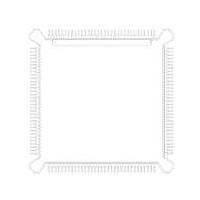MC68HC16Z1CEH16 Freescale Semiconductor, MC68HC16Z1CEH16 Datasheet - Page 152

MC68HC16Z1CEH16
Manufacturer Part Number
MC68HC16Z1CEH16
Description
IC MCU 16BIT 16MHZ 132-PQFP
Manufacturer
Freescale Semiconductor
Series
HC16r
Specifications of MC68HC16Z1CEH16
Core Processor
CPU16
Core Size
16-Bit
Speed
16MHz
Connectivity
EBI/EMI, SCI, SPI
Peripherals
POR, PWM, WDT
Number Of I /o
16
Program Memory Type
ROMless
Ram Size
1K x 8
Voltage - Supply (vcc/vdd)
2.7 V ~ 5.5 V
Data Converters
A/D 8x10b
Oscillator Type
Internal
Operating Temperature
-40°C ~ 85°C
Package / Case
132-QFP
Processor Series
HC16Z
Core
CPU16
Data Bus Width
16 bit
Controller Family/series
68HC16
No. Of I/o's
26
Ram Memory Size
1KB
Cpu Speed
16MHz
No. Of Timers
2
Embedded Interface Type
QSPI, SCI
Rohs Compliant
Yes
Package
132PQFP
Family Name
HC16
Maximum Speed
16 MHz
Operating Supply Voltage
3.3|5 V
Number Of Programmable I/os
16
On-chip Adc
8-chx10-bit
Number Of Timers
11
Data Ram Size
1 KB
Interface Type
SCI, SPI, UART
Maximum Clock Frequency
16 MHz
Maximum Operating Temperature
+ 85 C
Mounting Style
SMD/SMT
Minimum Operating Temperature
- 40 C
Lead Free Status / RoHS Status
Lead free / RoHS Compliant
Eeprom Size
-
Program Memory Size
-
Lead Free Status / Rohs Status
Lead free / RoHS Compliant
Available stocks
Company
Part Number
Manufacturer
Quantity
Price
Company:
Part Number:
MC68HC16Z1CEH16
Manufacturer:
Freescale Semiconductor
Quantity:
10 000
Part Number:
MC68HC16Z1CEH16
Manufacturer:
FREESCALE
Quantity:
20 000
- Current page: 152 of 500
- Download datasheet (6Mb)
5.6.6 External Bus Arbitration
5-46
The halt operation has no effect on bus arbitration. However, when external bus arbi-
tration occurs while the MCU is halted, address and control signals go into a high-im-
pedance state. If HALT is still asserted when the MCU regains control of the bus,
address, function code, size, and read/write signals revert to the previous driven
states. The MCU cannot service interrupt requests while halted.
The MCU bus design provides for a single bus master at any one time. Either the MCU
or an external device can be master. Bus arbitration protocols determine when an ex-
ternal device can become bus master. Bus arbitration requests are recognized during
normal processing, HALT assertion, and when the CPU has halted due to a double
bus fault.
The bus controller in the MCU manages bus arbitration signals so that the MCU has
the lowest priority. External devices that need to obtain the bus must assert bus arbi-
tration signals in the sequences described in the following paragraphs.
Systems that include several devices that can become bus master require external cir-
cuitry to assign priorities to the devices, so that when two or more external devices at-
tempt to become bus master at the same time, the one having the highest priority
becomes bus master first. The protocol sequence is:
BR can be asserted during a bus cycle or between cycles. BG is asserted in response
to BR. To guarantee operand coherency, BG is only asserted at the end of operand
transfer.
If more than one external device can be bus master, required external arbitration must
begin when a requesting device receives BG. An external device must assert BGACK
when it assumes mastership, and must maintain BGACK assertion as long as it is bus
master.
Two conditions must be met for an external device to assume bus mastership. The de-
vice must receive BG through the arbitration process, and BGACK must be inactive,
indicating that no other bus master is active. This technique allows the processing of
bus requests during data transfer cycles.
BG is negated a few clock cycles after BGACK transition. However, if bus requests are
still pending after BG is negated, the MCU asserts BG again within a few clock cycles.
This additional BG assertion allows external arbitration circuitry to select the next bus
master before the current master has released the bus.
Refer to
shows BR negated at the same time BGACK is asserted.
1. An external device asserts the bus request signal (BR).
2. The MCU asserts the bus grant signal (BG) to indicate that the bus is available.
3. An external device asserts the bus grant acknowledge (BGACK) signal to indi-
cate that it has assumed bus mastership.
Figure
5-17, which shows bus arbitration for a single device. The flowchart
Freescale Semiconductor, Inc.
For More Information On This Product,
SYSTEM INTEGRATION MODULE
Go to: www.freescale.com
M68HC16 Z SERIES
USER’S MANUAL
Related parts for MC68HC16Z1CEH16
Image
Part Number
Description
Manufacturer
Datasheet
Request
R
Part Number:
Description:
Manufacturer:
Freescale Semiconductor, Inc
Datasheet:
Part Number:
Description:
Manufacturer:
Freescale Semiconductor, Inc
Datasheet:
Part Number:
Description:
Manufacturer:
Freescale Semiconductor, Inc
Datasheet:
Part Number:
Description:
Manufacturer:
Freescale Semiconductor, Inc
Datasheet:
Part Number:
Description:
Manufacturer:
Freescale Semiconductor, Inc
Datasheet:
Part Number:
Description:
Manufacturer:
Freescale Semiconductor, Inc
Datasheet:
Part Number:
Description:
Manufacturer:
Freescale Semiconductor, Inc
Datasheet:
Part Number:
Description:
Manufacturer:
Freescale Semiconductor, Inc
Datasheet:
Part Number:
Description:
Manufacturer:
Freescale Semiconductor, Inc
Datasheet:
Part Number:
Description:
Manufacturer:
Freescale Semiconductor, Inc
Datasheet:
Part Number:
Description:
Manufacturer:
Freescale Semiconductor, Inc
Datasheet:
Part Number:
Description:
Manufacturer:
Freescale Semiconductor, Inc
Datasheet:
Part Number:
Description:
Manufacturer:
Freescale Semiconductor, Inc
Datasheet:
Part Number:
Description:
Manufacturer:
Freescale Semiconductor, Inc
Datasheet:
Part Number:
Description:
Manufacturer:
Freescale Semiconductor, Inc
Datasheet:











